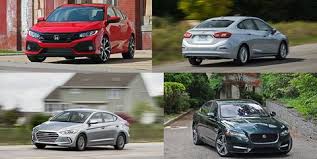Buying a car is one of the biggest decisions of your life. Each person has their own set of desires and needs: color, size, price, fuel efficiency, performance, reliability, safety, comfort, luxury and style.
Whether you have a need for speed or a craving for comfort, Auto Simple wants to help you choose the type of car that’s right for you. One of the first and most important things to take into consideration is the car body style.
Most cars are divided into 2-box and 3-box body styles, with up to four “pillars.” The pillars refer to posts or supports around the vehicle’s windows. For instance, a sedan or hatchback will usually have 3 pillars, while an SUV or station wagon will have 4 pillars.
Source: Wikimedia Commons
Take a look at the different car body style descriptions below to find the car design that’s right for you.
1. Sedan

Image: 2013 Chevrolet Impala LT
Let’s start with the basics.
A sedan, also known as a saloon in other countries, is the most popular body style. It typically features two rows of seats, 4 doors, and a 3-box configuration.
Sedans tend to provide better fuel economy, affordability, handling, and performance. New drivers in particular favor the sedan over other body types for their safety and handling. If you are looking for a practical, commuter car with space for passengers, a sedan is the classic choice.
Since they are closer to the ground and have a lower center of gravity, they tend to perform better around corners and sharp turns than larger vehicles such as SUVs. As a result, they are much less prone to tipping and rolling over than trucks and SUVs. With less weight and a lower center of gravity, it’s easier to move and better for the environment.
The biggest downside of a sedan is the space. The sedan’s lower position gives it a tighter grip on the road, but also a more awkward storage space. Instead of a large storage area with foldable seats, expect a relatively small space tucked between the wheelbase. Head and leg room can also be an issue for some car buyers. If need a little more space, check out the hatchback and crossover options.While it may not be the flashiest or most spacious car on the road, you’ll be able to get from point A to point B safely and efficiently. Consider a Chevrolet Malibu, Honda Civic, Toyota Corolla, Ford Focus, or another reliable family sedan.
2. Coupe

Image: 2007 Mitsubishi Eclipse SE
A coupe, or French coupé, has two doors and a low, fixed roof, giving it a sporty feel. Up until the 1960s, convertibles were sometimes called drop-head coupes. Now, however, coupes refer exclusively to fixed head models.
Coupes are stylish cars best for singles or couples. Coupes and convertibles attract a similar kind of buyer—someone who values style and experience just as much as utility and performance.
Since space isn’t the priority, car designers can focus on muscle, stylish features, and performance.
The doors tend to be wider and the roof lower. It is shorter than a sedan and may or may not have a back seat. If there is back seating, it might be a little tighter than you may find comfortable.
Coupe customers sacrifice space for performance and aesthetics. Without kids or the need to haul stuff, a coupe or convertible could be a great option. Convertibles and coupes are fun, great for relationships, and you can sun tan on your commute.
If, however, you regularly travel with more than one passenger, a larger vehicle will probably suit your needs better.
3. Hatchback

Image: 2011 Dodge Caliber Mainstreet
A hatchback is smaller than an SUV or minivan, but larger than a sedan. The main difference between a hatchback and a sedan is the extended trunk. Instead of the back sloping downwards, the back area is lifted, providing extra space for cargo.
Typically, the hatchback has a top-hinged trunk with rear seats that fold down for even more cargo space. As a result, hatchbacks are usually marketed as small family cars or executive cars.
Since the interior space can be made to prioritize passengers or cargo, they are a popular and practical choice for those who need both. From small city hatchbacks to large luxury models, there is a wide variety of hatchbacks available to you.
4. SUV

Image: 2009 Ford Escape XLT
SUV stands for Sports Utility Vehicle. It is a larger vehicle that can be classified as a light truck. With a higher center of gravity, higher ground clearance, and four-wheel drive, you’ll have a more commanding view of the road.
SUVs prioritize size and comfort, and can provide a more adventurous ride than minivans or station wagons. They are designed for both on and off-road use. Dads tend to prefer SUVs due to their four-wheel drive capabilities, towing capacity, and masculine appeal.
5. Crossover

Image: 2007 Pontiac Vibe
A cross between a sedan and an SUV, crossovers (also known as Crossover Utility Vehicles) give you the best of both worlds. If you frequently haul things and would like a little more room than a sedan, consider looking at the wide range of crossovers. They are available in four-wheel, rear-wheel, and all-wheel drives.
They are cheaper and have better fuel economy than full-sized SUVs while still giving you extra ground clearance and a more commanding view of the road. Keep in mind that they are only designed for light off-roading, unlike SUVs.
6. Minivan/Van

Image: 2009 Chrysler Town & Country LX
Despite the rising preference for crossovers (CUVs) and SUVs, vans and minivans are still the classic family car choice. Sometimes called Multi-Purpose Vehicles (MPVs), they are taller than station wagons and offer spacious 3 row seating for 7 or more passengers.
While you may be tempted by a modern-looking crossover, minivans tend to have more cargo space, more ways to configure the interior, comfortable third row seats, easy access, and plenty of storage cubbies.
They may not be the sleekest or sexiest cars on the road, but what they lack in looks they make up for in functionality. The boxy shape and square doors make it easy to haul any combination of cargo and people. If you have a large family, this is a car designed for you.
7. Pickup

Image: 2010 Ford F-150 XL
Pickup trucks command the road. They are big, rugged cars designed to perform big, rugged tasks. Sitting high, you’ll have a bird’s eye view of the road.
Pickups are a great option for people who have a lot of stuff to haul around. With an open rear cargo area known as a “bed,” you won’t be hindered by cabin height. Truck beds are also great for tailgating, camping, stargazing, and creative modifications (mini pool, anyone?)
Whether you are hauling a boat to Galveston or jump-starting a home service business, you’ll be able to do it all with the right pickup truck. Keep in mind that you’ll probably be the first one to call on moving day.
8. Wagon

Image: 2009 Toyota Matrix
Mention station wagon and most of us think of our parents or National Lampoon’s Vacation. As tastes changed, Americans began to prefer smaller, more fuel efficient vehicles, or minivans and SUVs for families.
Today, there aren’t many automakers who still make and market station wagons. It’s important to note, however, that modern-day station wagons have evolved quite a bit. You won’t be seeing any vinyl or wood siding here.
Before you opt for a large SUV, consider that a station wagon probably has all of the amenities you need. Wagons have nearly everything a crossover has, including four-wheel drive, spacious interiors, advanced tech, and high performance and efficiency.
Will there be a return to the glory days of the family station wagon? Sadly, no. But if you need to transport people and gear, don’t forget about the faithful wagon. They are still a great choice for city and country driving, and have the durability and handling necessary for more rugged terrain.
NOTE: Car body style definitions vary from company to company and person to person. Many times, body styles are used for marketing and PR purposes. For instance, a station wagon can easily be marketed as a crossover.






























